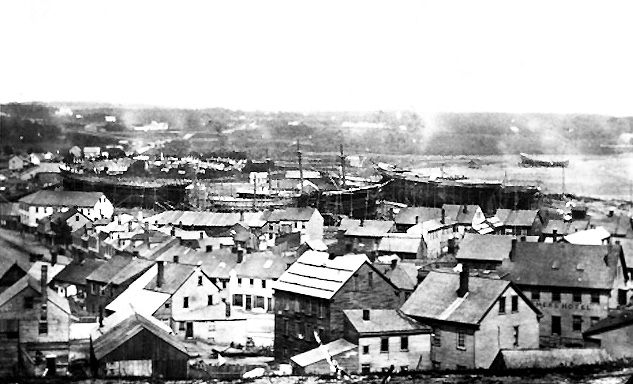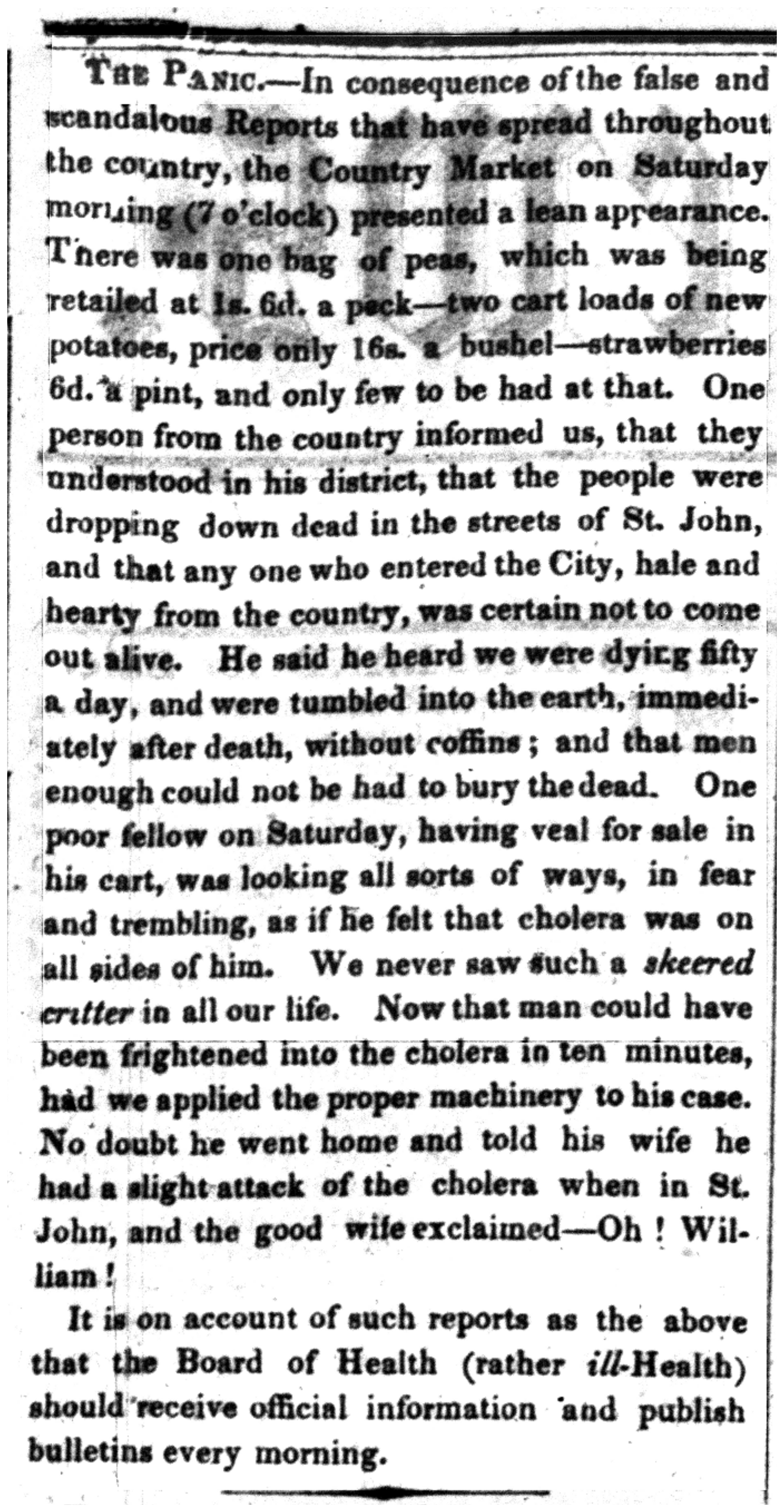- Submitted on
- 0 comments
The citizens of Saint John, New Brunswick were gripped by fear during the mid-nineteenth century as a haunting spectre was sweeping the globe. Yet, this menace was not of a paranormal nature. Rather, it was one of humanities oldest foes: contagious disease, this time in the form of cholera. During both the 1830s and 1850s, Saint John would experience two outbreaks of this deadly illness, profoundly changing the lives of the town’s vulnerable population.
The disease known as cholera is transmitted to humans via water and food that is contaminated, specifically with the bacterium vibrio cholerae. Those infected often display no symptoms; however, if left untreated, severe dehydration can occur and ultimately can lead one to die of shock. Thus, in order to prevent exposure to the disease, individuals must avoid polluted fluids and ensure the provision of clean drinking water and waste management. Unfortunately for our mid-nineteenth century Saint John friends, sanitation efforts were not nearly as advanced as they are today.
The first mention of cholera appearing in Saint John occurs in the summer of 1832; during a Special Sessions of the Peace held in the city Court House, the Board of Health requested that financial aid be given from the province in order to take measures in “guarding against Asiatic Cholera”. Based on this request, two implications can be drawn. The first, that cholera had not yet infected anyone within Saint John, as the government was aiming to prevent the introduction of the disease, and the second, that it was believed by those within the city that the illness originated from somewhere in Asia. This is consistent with the history of cholera, as the first major outbreak occurred in India in 1817. Furthermore, suggestions were made to require businesses such as taverns to be forced to close early in order to help prevent outbreaks, and the construction of a “cholera hospital” was ordered in the winter of 1832.
All of the previously mentioned events took place during a cholera pandemic that spanned the early 1830s and spread throughout much of Europe and Eastern North America. However, the disease itself never reached catastrophic levels in Saint John; the number of deaths was relatively small in comparison to, say, Halifax, where nearly 400 people were killed. It was not until twenty years later that the spectre of cholera would return to haunt the citizens of Saint John in such a devastating way.
In 1854, life was not particularly easy for residents of southern New Brunswick. The Crimean War was raging in Europe and demand for supplies resulted in record-high prices in the province, while wages remained stagnant. The poor, in particular, had it rough; in Saint John, they mostly lived in slums by the waterfront that were vastly overcrowded. Sanitary measures were minimal, with many drains/sewers being defective, while the town’s water supply was privately owned (in other words, water was expensive) and unclean (most people would have been better off drinking rainwater!). Attempts at protecting the city against contagious diseases were minimal, as were general efforts to clean up areas within town. When the idea of having city councilors supervise sanitation measures in local wards was suggested, many protested that such an undertaking was “beneath the dignity of any member of the Board to be the Scavenger of the Ward.” (Apparently, some of the councilors had a high degree of self-importance). Therefore, by 1854, conditions were prime for an outbreak of cholera, which was lurking just around the corner.
The disease itself was introduced to the region in April when the ship Blanche arrived from England. Several people had died during the voyage and many of the passengers were, to be blunt, filthy. Thus, all of the passengers were quarantined on an island within the city’s harbour; by early May, most had been allowed to leave. Many of those who did enter the city resided in the impoverished and overcrowded sections of town, a key ingredient for a recipe of disaster.

By June, talk of the presence of cholera in Saint John began to spread. Mentions of the disease by name did not appear in local newspapers until July, and even then most articles were speculative in nature. For example, in the July 21st edition of the Morning News, an article was included, submitted by the Board of Health, which touched upon the rumours that were flourishing: “Some of the most ridiculous reports…have been in circulation. For instance, it was alleged that there were ten persons lying dead on Tuesday last in Lower Cove. We at once instituted a rigid inquiry… and learned that there was not a single case of what some people called cholera.” The Board, however, did pledge to carry out regular inspections, acknowledging the fact that an unusual number of citizens were becoming ill with some disease.
As the dog days of summer wore on, public panic grew. The July 24th edition of the Morning News contained an article entitled “The Panic”, which highlighted the mass hysteria in the city, “One person…informed us that they understood in his district that the people were dropping dead in the streets of St. John, and that anyone who entered the City was certain not to come out alive. He said he heard we were dying fifty a day . . .One poor fellow on Saturday . . . was looking all sorts of ways, in fear and trembling, as if he felt that cholera was on all sides of him. We never saw such a skeered critter in all our life. ” In a later edition of the paper that month, scenes of hordes of people on the outskirts of the city leaving their homes via horse and wagon are described, “Perhaps there never was such a circumstance anywhere, since the people of Moscow evacuated their City, on the approach of Napoleon’s grand army in 1812.” Businesses were said to be failing, residents began taking refuge in the woods, and the streets of Saint John were becoming vacant. All in all, the authors of the article urged the Board of Health to begin publishing information regarding the outbreak (including death tolls) so as to dispel of any false rumours and hysterical actions.

In response to the outbreak and its resulting panic, many remedies were proposed to fight off the disease. Once such solution published in the Morning News on August 6th promised for the “total annihilation” of cholera, in which a townsman recalled an episode of cholera that occurred in his hometown in Ireland, where the illness had been raging. Here, citizens gathered together and began lighting bonfires in the streets. Despite objections from the town’s doctors, the so-called remedy seemed to work, in the townsman’s view, for “not a cholera patient could be ferreted out in the town or neighborhood next day, nor next… and on the fourth day after the Bonfires the Cholera Hospital was closed up.” Apparently, the flames and heat seemed to purify the air (although this is very likely a useless procedure). Barrels of tar were eventually burned within Saint John, with the hopes of achieving a similar effect.
By the beginning of September 1854, the epidemic had begun to rapidly subside and the citizens of Saint John slowly began to readjust. However, cholera had taken a tremendous toll on the city; out of a population of roughly 30,000, at least 1,100 (and possibly over 1,500) people were killed. The city had never witnessed such a destructive phenomenon and was determined to prevent future occurrences. Calls for vast overhauls to the local sewage and water systems were made. Although slow and impeded, eventually much was done in the way of improving the water supply such as new reservoirs, more widespread water access. Furthermore, the epidemic had a deep effect on the local medical community, who once disregarded the theory of diseases being contagious but now had changed their minds to the evolution of the outbreak. All in all, the cholera plague profoundly affected the lives of nineteenth-century Saint Johners, and has stood as one of the worst cholera episodes in Canadian history.
Primary Sources
Morning News (Saint John, NB). University of New Brunswick, Microforms.
New Brunswick. Court of General Quarter Sessions of the Peace (St. John County). Minutes: 1812-1839 . The Loyalist Collection.
Secondary Sources
Bilson. Geoffrey. “The Cholera Epidemic in Saint John, N.B., 1854.” Acadiensis 4, no. 1 (1974): 85-99.
“Cholera.” World Health Organization. August 2017. http://www.who.int/mediacentre/factsheets/fs107/en/
“An Epidemic of Cholera in Halifax, Nova Scotia, 1834.” Nova Scotia Medical Bulletin 14, no.11 (1935): 587-596.
“Origins of Cholera.” Cholera and the Thames. August 2017. http://www.choleraandthethames.co.uk/cholera-in-london/origins-of-cholera/
Gregg Watts is a recent graduate from St. Thomas University with a Bachelor of Arts degree in Economics and worked as a student assistant in the Microforms Unit.

Add new comment